Understanding music modes is a game-changer for any producer.
Not only does it provide a solid foundation in music theory, but it also allows you to explore new melodies and harmonies that can give your tracks a unique character, depth, and feel.
Today, we’ll guide delve into all the music modes and when to use them, providing examples, creative tips and techniques, and popular songs that utilize the respective mode.
The 7 different music modes are:
- Ionian
- Dorian
- Phrygian
- Lydian
- Mixolydian
- Aeolian
- Locrian
These unique music modes open up a whole new world of possibilities when creating melodies, harmonies, and even chord progressions.
By the end of this guide, you’ll have all the knowledge you need to start incorporating these music modes into your own tracks and create truly captivating tracks.
Let’s dive in…
Table of Contents
- Music Theory: Quick Recap
- The Major Scale
- C Major Scale
- Note Combinations
- The Minor Scale
- What Is a Scale Degree?
- The Seven Music Modes: Breaking it Down
- 1. Ionian Mode
- 2. Dorian Mode
- 3. Phrygian Mode
- 4. Lydian Mode
- 5. Mixolydian Mode
- 6. Aeolian Mode
- 7. Locrian Mode
- Parent Scale Method
- Role of Church Modes and Greek Modes
- Evolution of Modal Music Throughout History
- Tips & Techniques for Incorporating Music Modes
- Final Thoughts
Music Theory: Quick Recap
In order to truly grasp the 7 different music modes in all their glory, you must have a basic understanding of Music Theory.
It provides the tools and knowledge necessary to create captivating compositions.
By comprehending the principles of Theory, you can effectively use modes and scales to create:
- Unique melodies
- Harmonies
- Chord progressions
So, let’s quickly recap Major chords, Minor chords, and scale degrees before jumping into the specific music modes.
The Major Scale
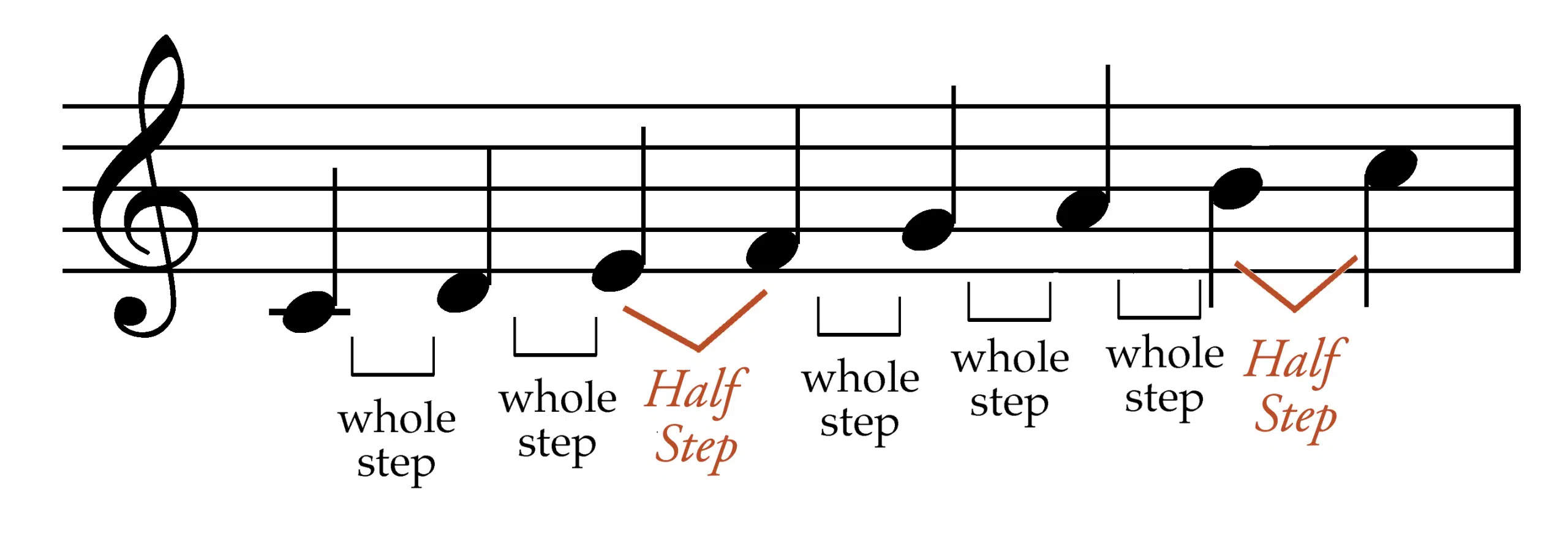
The Major scale is a seven-note diatonic scale, constructed using a specific pattern of whole and half steps.
Starting from the root note, the pattern is:
- Whole
- Whole
- Half
- Whole
- Whole
- Whole
- Half
By following this pattern from any starting pitch, you can create a Major Scale in any key.
This consistent formula is part of what makes the Major Scale a fundamental element in Theory and allows for easy transposition of melodies and harmonies between keys.
The Major scale is the foundation for Western music and serves as the basis for many other scales and modes.
Its bright and uplifting sound has been a driving force in shaping the musical landscape across various genres, including hip-hop.
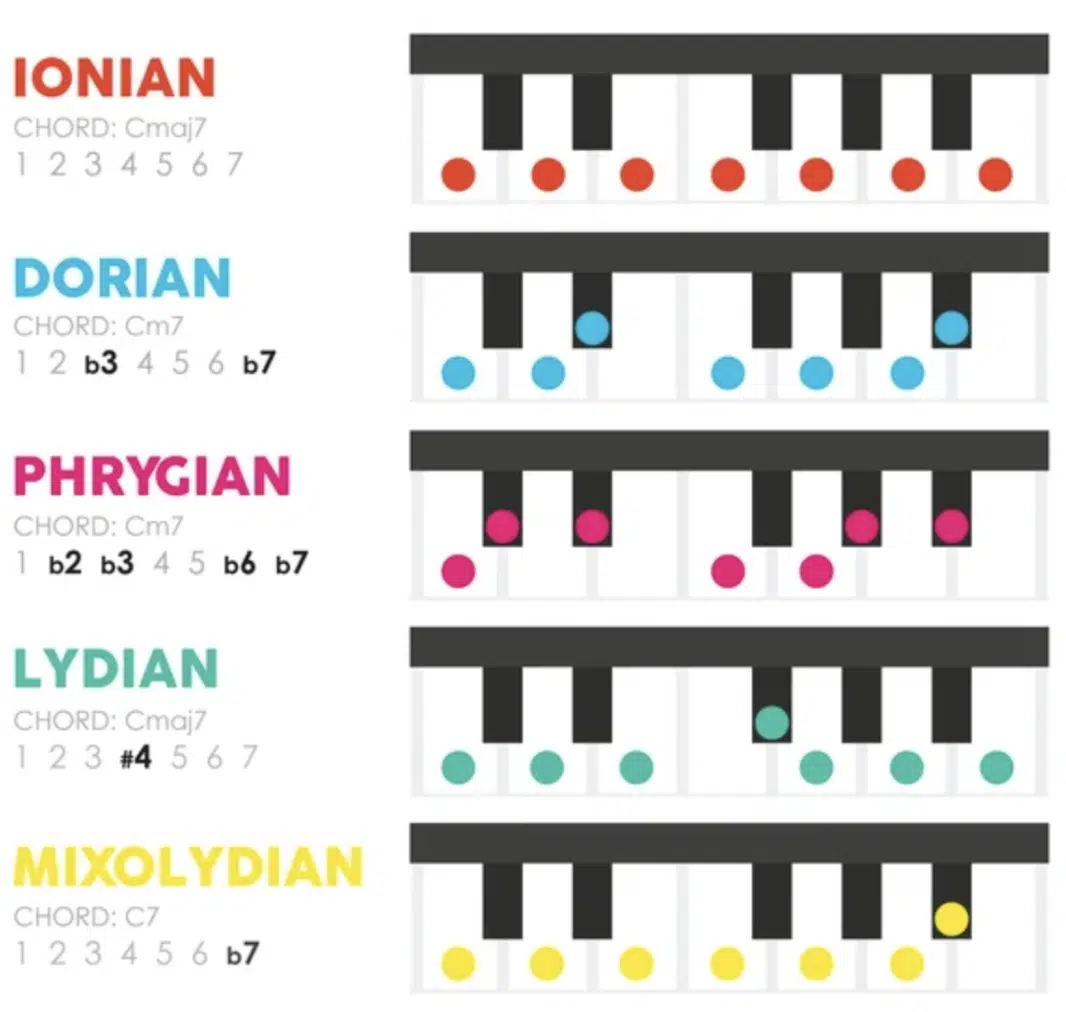
If you’re just learning how to become a music producer, make sure to start with mastering the Major scale before moving on to more complicated variations.
C Major Scale
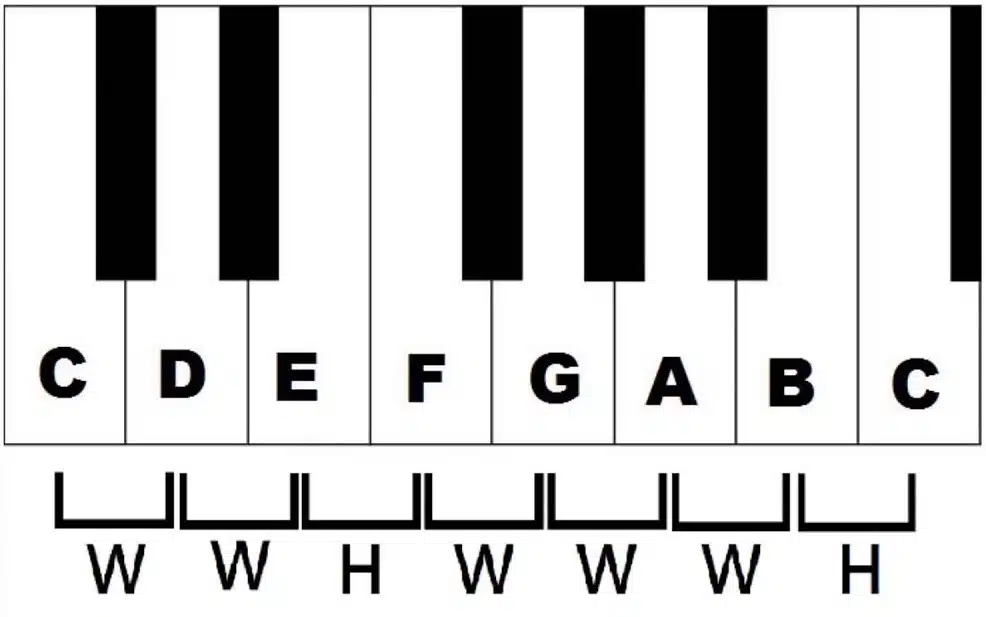
The C Major scale is a popular major scale, as it contains only natural notes (no sharps or flats).
The notes in the C Major scale formula are: C D E F G A B.
It serves as an excellent starting point for understanding major scales and their modes, as well as for learning Western music theory and composition.
By analyzing the different scale degrees in the C Major scale, you can gain valuable insights into how different notes function within a piece of music.
As well as how they can be used to create engaging melodies and harmonies.
For instance, you can use the C Major scale to create a simple chord progression such as I-IV-V-I (C Major – F Major – G Major – C Major).
This progression is a staple in many genres of music and showcases the function of scale degrees within harmony.
Note Combinations
- F G A B 一 This sequence of notes can be used to create interesting melodic patterns and harmonies.
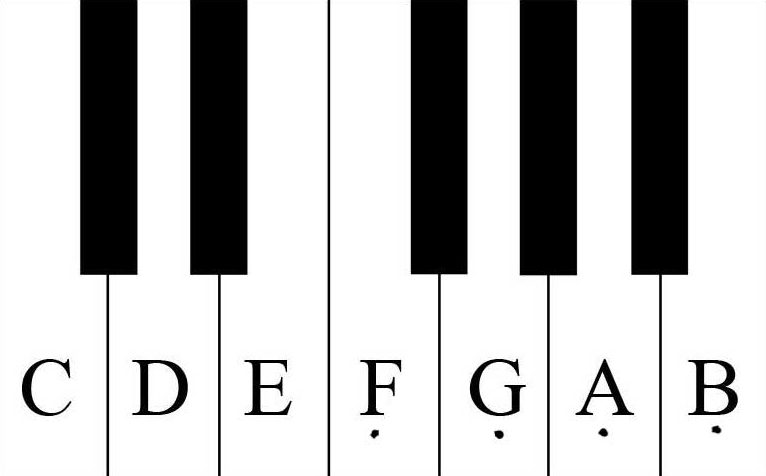
- G A B C 一 Another important note combination in the C Major scale, this sequence can be employed to create captivating melodies and chord progressions.
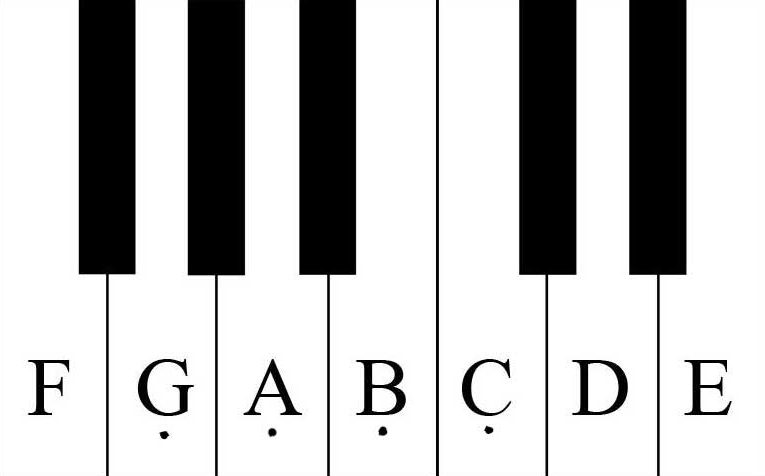
- C D E F 一 This note sequence is the beginning of the C Major scale and can be used to establish the tonality of your composition.
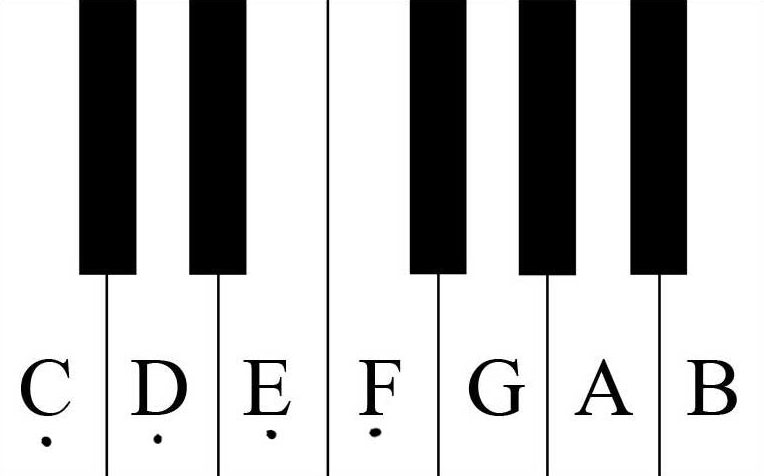
Incorporating different note combinations from the major scale can help you create captivating melodies, harmonies, and chord progressions.
Try experimenting with each variation because you never know what might call you.
The Minor Scale

The minor scale is another essential diatonic scale in Western music, characterized by its more somber and introspective sound compared to the major scale.
The natural minor scale follows a specific pattern of whole and half steps
- Whole
- Half
- Whole
- Whole
- Half
- Whole
- Whole
This arrangement of steps contributes to the distinct emotional quality of the minor scale, making it a popular choice for genres that require a more emotional or moody vibe.
It has the power to transport listeners to a realm of deep emotion and introspection.
By using it, you’ll be able to evoke strong feelings and create an unforgettable atmosphere in your compositions.
For example, in the key of A Minor (A B C D E F G), the whole and half steps occur in the following pattern: whole, half, whole, whole, half, whole, whole.
Using different note combinations from the natural minor scale can help you create compelling melodies, harmonies, and chord progressions.
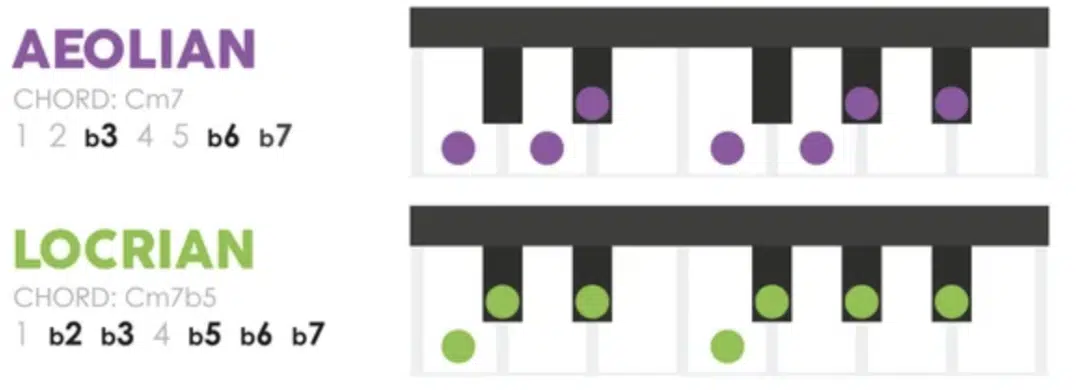
Understanding major and minor scales are crucial in mastering all the music modes.
What Is a Scale Degree?
A scale degree refers to the position of a note within a scale.
In a seven-note scale, such as the major and minor scales, there are seven scale degrees, each represented by a number from 1 to 7.

- Tonic (I) – The first and most stable note of the scale, serving as the foundation or home base.
- Supertonic (II) – The second degree, one whole step above the tonic.
- Mediant (III) – The third degree, located midway between the tonic and dominant.
- Subdominant (IV) – The fourth degree, located a perfect fifth below the tonic and a perfect fourth above it.
- Dominant (V) – The fifth degree. This is a crucial note for establishing the key and creating tension that resolves back to the tonic.
- Submediant (VI) – The sixth degree, located midway between the subdominant and tonic.
- Leading Tone (VII) – The seventh degree, a half step below the tonic, creates a strong pull to resolve upward to the tonic in major scales. In natural minor scales, this degree is called the Subtonic, as it is a whole step below the tonic.
Understanding scale degrees is crucial for navigating different modes and scales, creating chord progressions, and composing melodies.
The Seven Music Modes: Breaking it Down
There are seven different music modes, and each one of the music modes consists of unique combinations of the major and minor scales, offering distinct sonic characteristics.
Let’s take a closer look at each one:
1. Ionian Mode

The Ionian mode, also known as the major scale, is the foundation of Western music and serves as the basis for many other scales and modes.
Like the other six modes, it has its roots in ancient Greek modes.
In the key of C, the Ionian mode consists of the following notes: C D E F G A B.
The Ionian mode is known for its inspiring and uplifting sound, which makes it a popular choice for various music genres, such as pop and rock.
The specific arrangement of whole and half steps in the Ionian mode gives it a unique character and allows for the creation of diverse melodies and harmonies.
The pattern of whole and half steps in the Ionian mode is as follows:
- Whole
- Whole
- Half
- Whole
- Whole
- Whole
- Half
![]()
A popular chord progression in the Ionian mode is the I-IV-V-I progression.
In the key of C, this would be C Major – F Major – G Major – C Major.
The Beatles’ “Here Comes the Sun” is an iconic example of a song utilizing the Ionian mode.
The verses are primarily in the key of A Major, and the uplifting melody beautifully showcases the bright and happy qualities of the Ionian mode.
Creative Techniques & Applications
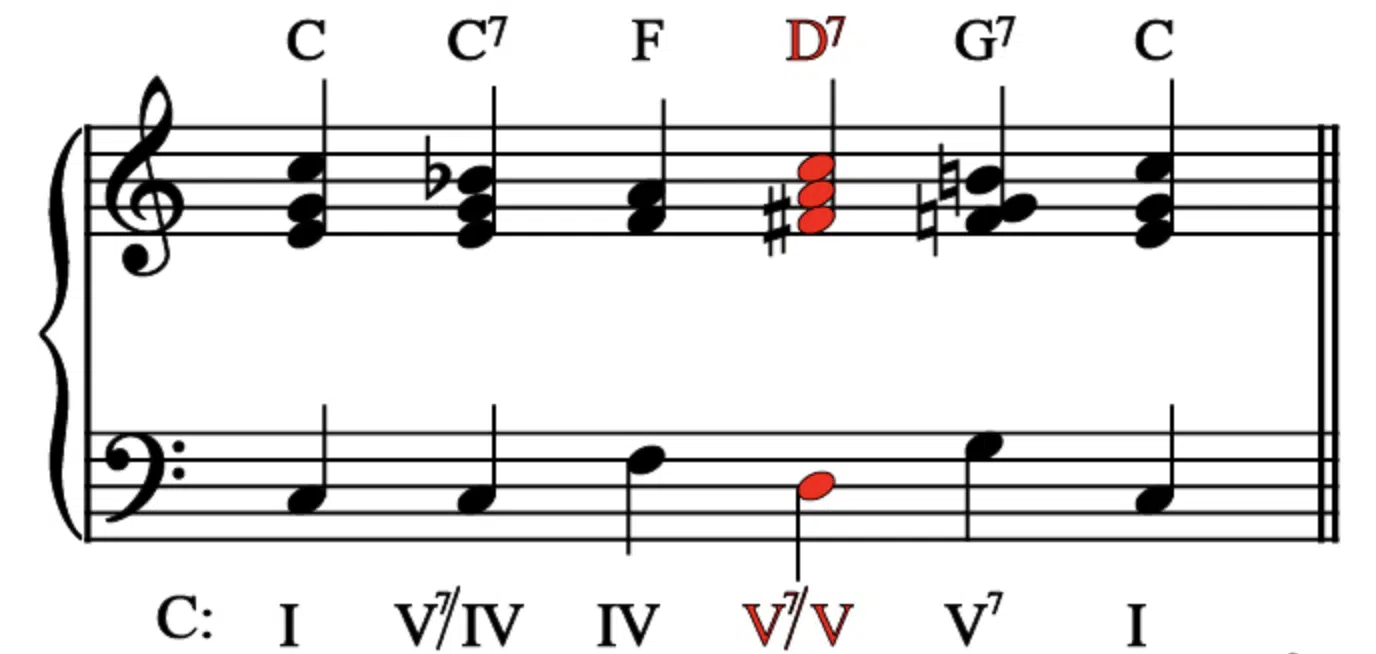
The Ionian mode can be utilized in various ways to create interesting music.
For instance, you can create memorable melodies by emphasizing the tonic (1st degree) and dominant (5th degree) notes.
Additionally, experimenting with different chord inversions and voicings can add depth and variety to your harmonies.
You can also use the Ionian mode to create tension and resolution within your compositions.
One technique is to introduce non-diatonic chords, such as secondary dominants or borrowed chords, which can momentarily shift the tonality before resolving back to the Ionian mode.
2. Dorian Mode

The Dorian mode is the second mode of the major scale, beginning on the second scale degree.
In the key of D, the Dorian mode consists of the following notes: D E F G A B C.
The Dorian mode has a unique blend of minor and major qualities, giving it a distinct sound.
It is somewhat darker than the Ionian mode but not as somber as the Aeolian mode (natural minor scale).
Actually, it was a favorite mode in medieval and Renaissance music, and it has enjoyed a resurgence in popularity in modern jazz and rock.
The Dorian mode is characterized by its raised 6th degree compared to the natural minor scale. It’s often used in jazz, blues, and rock music.
The pattern of whole and half steps in the Dorian mode is as follows:
- Whole
- Half
- Whole
- Whole
- Whole
- Half
- Whole
![]()
A popular chord progression in the Dorian mode is the i-v-IV progression.
In the key of D, this would translate to Dm-Am-G (D minor to A minor to G major).
One of the most well-known examples of a song utilizing the Dorian mode is “Get Lucky” by Daft Punk, featuring Pharrell Williams and Nile Rodgers.
The song’s infectious groove and catchy melody are built around the Dorian mode, giving it a unique and memorable sound.
Creative Techniques & Applications

The Dorian mode can be used to create interesting melodies and harmonies by emphasizing its unique characteristics.
One such characteristic is the raised 6th scale degree, which can be used to create a sense of tension or surprise within a melody.
Additionally, the Dorian mode works well with modal interchange, where chords from other parallel modes are borrowed to create more diverse and engaging harmonies.
Another technique for using the Dorian mode is to explore its potential for creating grooves and rhythmic patterns.
The mode’s somewhat dark yet energetic sound lends itself well to syncopated rhythms and intricate melodic lines, making it a popular choice for genres such as funk and fusion.
3. Phrygian Mode
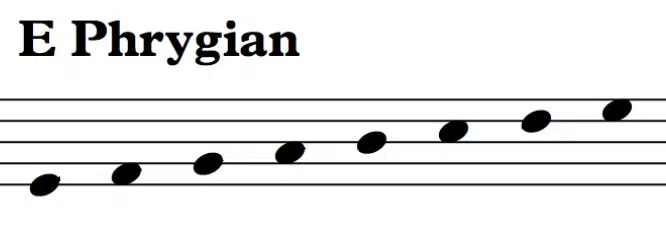
The Phrygian mode is the third mode of the major scale, starting on the third scale degree.
In the key of E, the Phrygian mode consists of the following notes: E F G A B C D.
It is characterized by its distinct, exotic sound, mainly due to the presence of a lowered 2nd degree compared to the major scale.
The Phrygian mode is commonly associated with Spanish and Middle Eastern music and has a somewhat mysterious and tense quality.
It’s often used in flamenco, metal, and various forms of electronic music and Techno.
The pattern of whole and half steps in the Phrygian mode is as follows:
- Half
- Whole
- Whole
- Whole
- Half
- Whole
- Whole
![]()
A common chord progression in the Phrygian mode (the third mode) is the i-II progression.
In the key of E, this would be E Minor – F Major.
“Loca” by Shakira is a popular song that incorporates the Phrygian mode.
The track’s exotic and catchy melody showcases the distinct sound of the Phrygian mode, which is likely to resonate with a younger audience
Creative Techniques & Applications
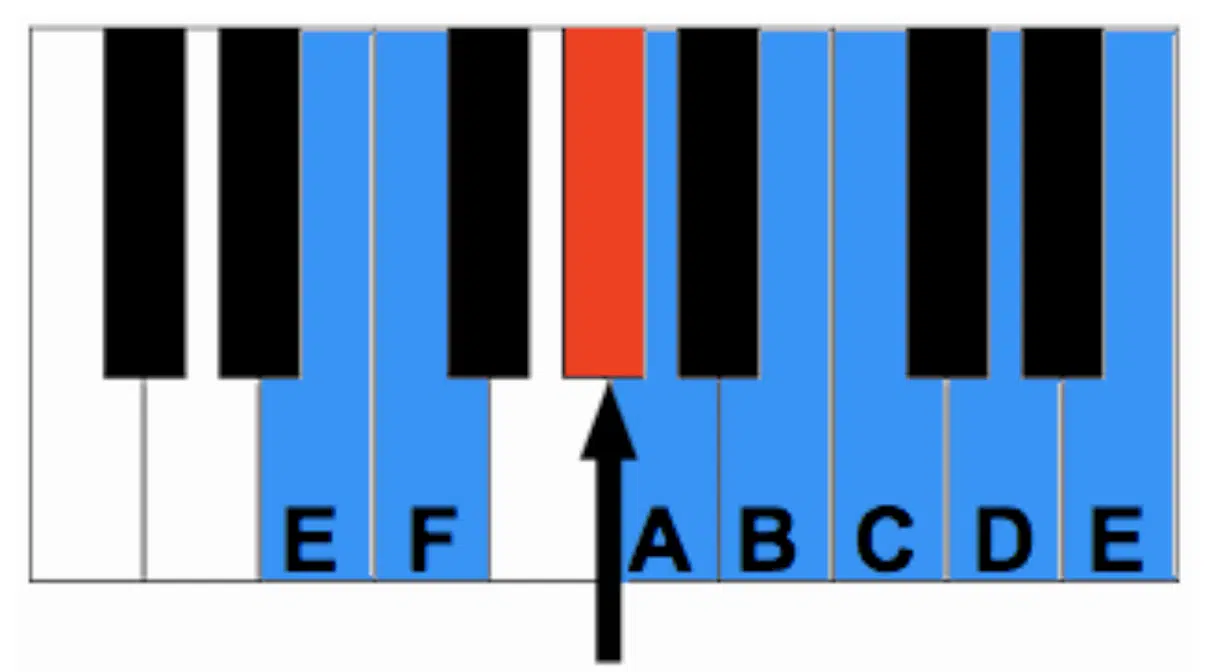
The Phrygian mode’s unique characteristics make it an excellent choice for creating captivating and emotionally charged music.
One way to emphasize the Phrygian mode’s distinct sound is to focus on the lowered 2nd scale degree or natural 3rd (instead of a flat 3rd).
They provide a sense of tension and exoticism.
You can also use the Phrygian mode to create more complex chord progressions by borrowing chords from parallel modes or experimenting with chromaticism.
This can lead to unexpected harmonic shifts that keep the listener engaged and intrigued.
Another technique for using the Phrygian mode is to explore its rhythmic potential, particularly in genres that benefit from its exotic sound.
Combining the Phrygian mode with syncopated rhythms and unusual time signatures can result in a rich and evocative musical landscape.
4. Lydian Mode

The Lydian mode is the fourth mode of the major scale, starting on the fourth scale degree.
In the key of F, the Lydian scale consists of the following notes: F G A B C D E.
It is characterized by its ethereal, dreamy sound, primarily due to the presence of a raised 4th degree compared to the major scale.
Interestingly, some ancient Greek philosophers, like Plato, believed that the Lydian mode had the power to induce a state of “drunkenness” in listeners.
Hence why it is often associated with a sense of wonder and otherworldliness.
The Lydian mode is frequently used in film scores, progressive rock, and jazz music.
The pattern of whole and half steps in the Lydian mode is as follows:
- Whole
- Whole
- Whole
- Half
- Whole
- Whole
- Half
![]()
A popular chord progression in the Lydian mode (the fourth mode) is the I-II progression.
In the key of F, this would be F Major – G Major.
“Dreams” by Coldplay is a good example of a song that uses the Lydian mode.
The uplifting and dreamy atmosphere created by the Lydian mode is reflected in the song’s title and lyrics, making it a great modern example for listeners to explore.
Creative Techniques & Applications

The Lydian mode offers a variety of possibilities for creating enchanting and atmospheric music.
To emphasize the Lydian mode’s unique sound, you can focus on the raised 4th scale degree in your melodies and harmonies.
This can create a sense of tension that resolves in a satisfying and uplifting manner.
Another technique for using the Lydian mode is to experiment with chord extensions and alterations, which can enhance the mode’s dreamy quality.
For example, you might use a major 7#11 chord (a major seventh chord with an added raised 4th) to create a rich, ethereal harmony.
The Lydian mode also works well for creating unique textures and ambient music.
By layering different voicings and chord inversions, you can build a lush and immersive sound that transports the listener to another world.
5. Mixolydian Mode

The Mixolydian mode is the fifth mode of the major scale, starting on the fifth scale degree.
In the key of G, the Mixolydian mode consists of the following notes: G A B C D E F.
It is characterized by its bluesy, dominant sound, mainly due to the presence of a lowered 7th degree compared to the major scale.
The Mixolydian mode is frequently used in various styles, such as blues, rock, and folk music.
Many popular guitar solos in rock music, such as those by Jimi Hendrix and Jerry Garcia, are based on the Mixolydian mode.
The pattern of whole and half steps in the Mixolydian mode is as follows:
- Whole
- Whole
- Half
- Whole
- Whole
- Half
- Whole
![]()
A popular chord progression in the Mixolydian mode is the I-IV-v progression.
In the key of G, this would be G Major – C Major – D Minor.
A contemporary example of a song that uses the Mixolydian mode is “Sweet Child O’ Mine” by Guns N’ Roses.
The main riff and melody, as well as the guitar solo, feature the Mixolydian mode, contributing to the iconic and memorable sound of this classic rock anthem.
Creative Techniques & Applications

The Mixolydian mode’s distinct sound makes it an excellent choice for creating music with a strong groove and a bluesy feel.
To emphasize the Mixolydian mode’s unique characteristics, you can focus on the lowered 7th scale degree.
This will provide a sense of tension that can be resolved either by returning to the tonic or by moving to another chord within the mode.
You can also experiment with chord progressions that highlight the Mixolydian mode’s dominant quality.
This can be achieved by using chords that contain the lowered 7th, such as dominant 7th chords or 9th chords.
Another technique for using the Mixolydian mode is to explore its rhythmic possibilities, particularly in genres that benefit from its bluesy and groovy sound.
Combining the Mixolydian mode with syncopated rhythms, swung rhythms, or complex time signatures can result in a vibrant and engaging musical experience.
6. Aeolian Mode

The Aeolian mode, also known as the natural minor scale, is the sixth mode of the major scale, starting on the sixth scale degree.
In the key of A, the Aeolian mode consists of the following notes: A B C D E F G.
It is characterized by its dark and moody sound, which makes it a popular choice for various genres that require a more emotional or melancholic atmosphere.
The Aeolian mode is known to evoke a sense of longing and desire, making it particularly beautiful.
The pattern of whole and half steps in the Aeolian mode is as follows
- Whole
- Half
- Whole
- Whole
- Half
- Whole
- Whole
![]()
A popular chord progression in the Aeolian mode is the i-IV-V progression.
In the key of A, this would be A Minor – D Major – E Major.
An epic song that showcases the Aeolian mode is “Blinding Lights” by The Weeknd.
The track features a catchy and emotive melody in the key of F# Aeolian, emphasizing the mode’s introspective and moody qualities.
Creative Techniques & Applications
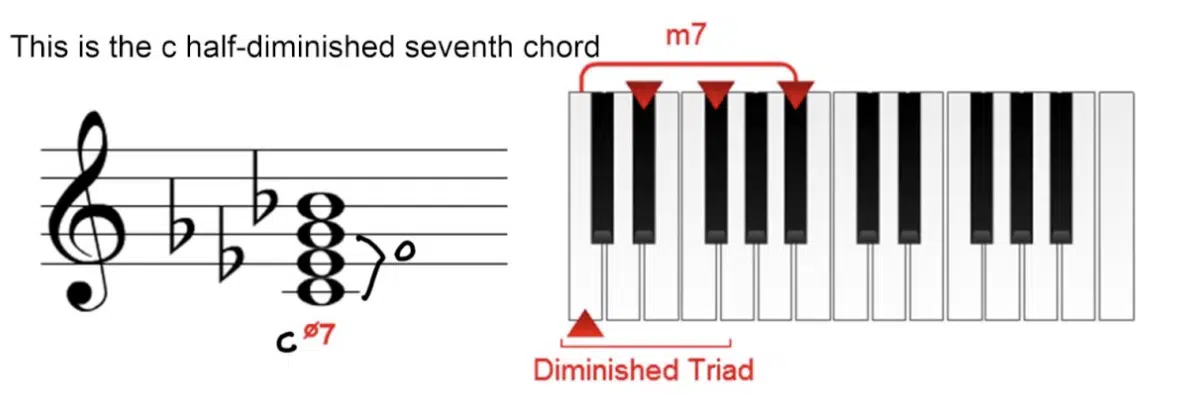
The Aeolian mode offers a variety of possibilities for creating emotionally charged music.
To emphasize the Aeolian mode’s unique sound, you can focus on the lowered 3rd, 6th, and 7th scale degrees, which provide a sense of sadness and introspection.
You can also experiment with chord progressions that highlight the Aeolian mode’s minor quality.
This can be achieved by using chords such as minor 7th chords, minor 9th chords, or half-diminished chords.
The Aeolian mode also works well for creating ambient and atmospheric music.
By layering different voicings and chord inversions, you can build a dark and immersive sound that evokes a sense of mystery and longing.
7. Locrian Mode

The Locrian mode is the seventh mode of the major scale, starting on the seventh scale degree.
In the key of B, the Locrian scale consists of the following notes: B C D E F G A.
It is characterized by its dissonant and unstable sound.
This is primarily due to the presence of a lowered 2nd and lowered 5th degree compared to the major scale.
The Locrian mode is the least commonly used of the seven modes and is often associated with experimental or avant-garde music.
The pattern of whole and half steps in the Locrian mode is as follows
- Half
- Whole
- Whole
- Half
- Whole
- Whole
- Whole
![]()
A chord progression in the Locrian mode is the i°-ii progression.
In the key of B, this would be B Diminished – C Major.
Radiohead’s “Everything in Its Right Place” features different types of chords derived from the Locrian mode.
The song’s haunting and unconventional harmony provides a unique listening experience that showcases the dissonance and tension of the Locrian mode.
NOTE: This music mode is rarely used in mainstream music, but it can be found in genres such as metal, jazz, and contemporary classical music.
Creative Techniques & Applications
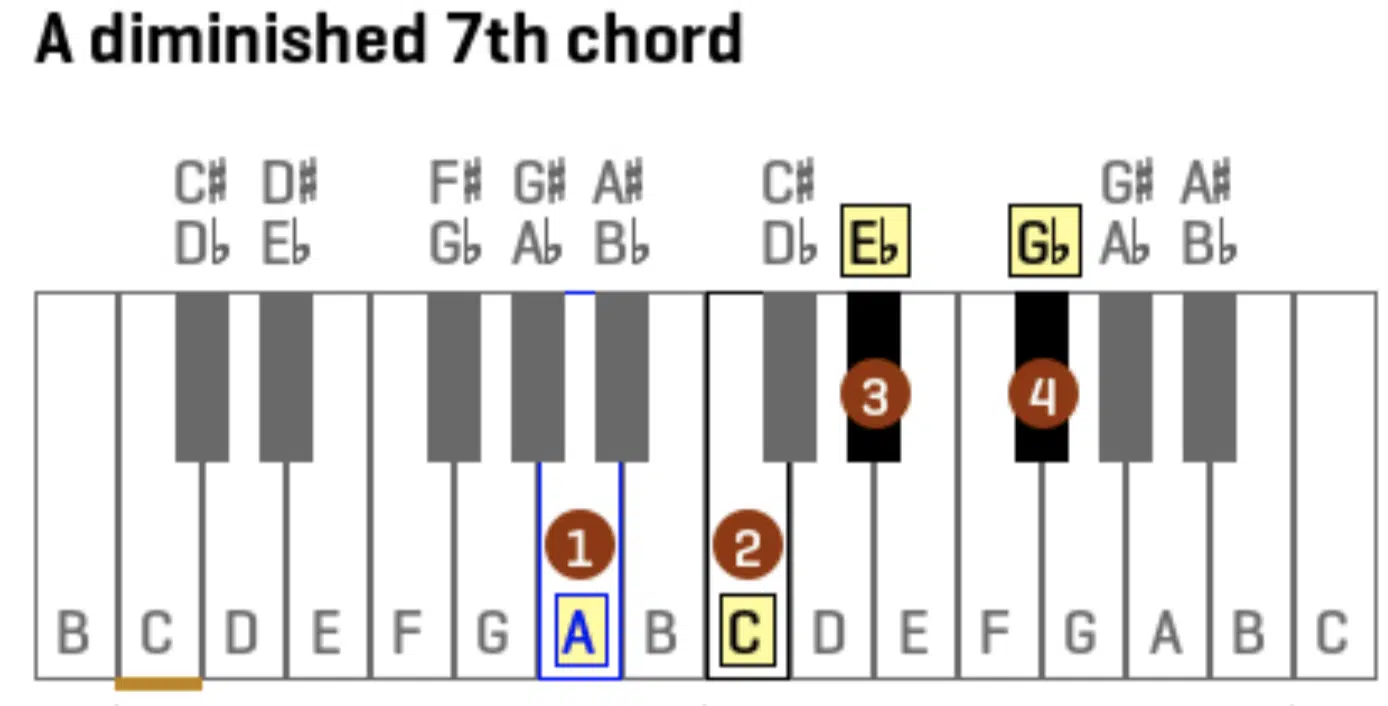
The Locrian mode’s unique characteristics make it an interesting choice for creating music with a sense of tension, dissonance, and instability.
To emphasize the Locrian mode’s distinct sound, you can focus on the lowered 2nd and lowered 5th scale degrees.
They provide a sense of unease and unresolved tension.
You can also experiment with chord progressions that highlight the Locrian mode’s diminished quality.
This can be achieved by using chords such as diminished 7th chords or half-diminished chords.
Another technique for using the Locrian mode is to explore its potential for creating tension and dissonance within your compositions.
By layering different voicings, chord inversions, and textures, you can create an unsettling and unpredictable musical soundscape that challenges the listener’s expectations.
Its distinctive sound can provide a unique and intriguing dimension to your compositions when used appropriately.
Parent Scale Method
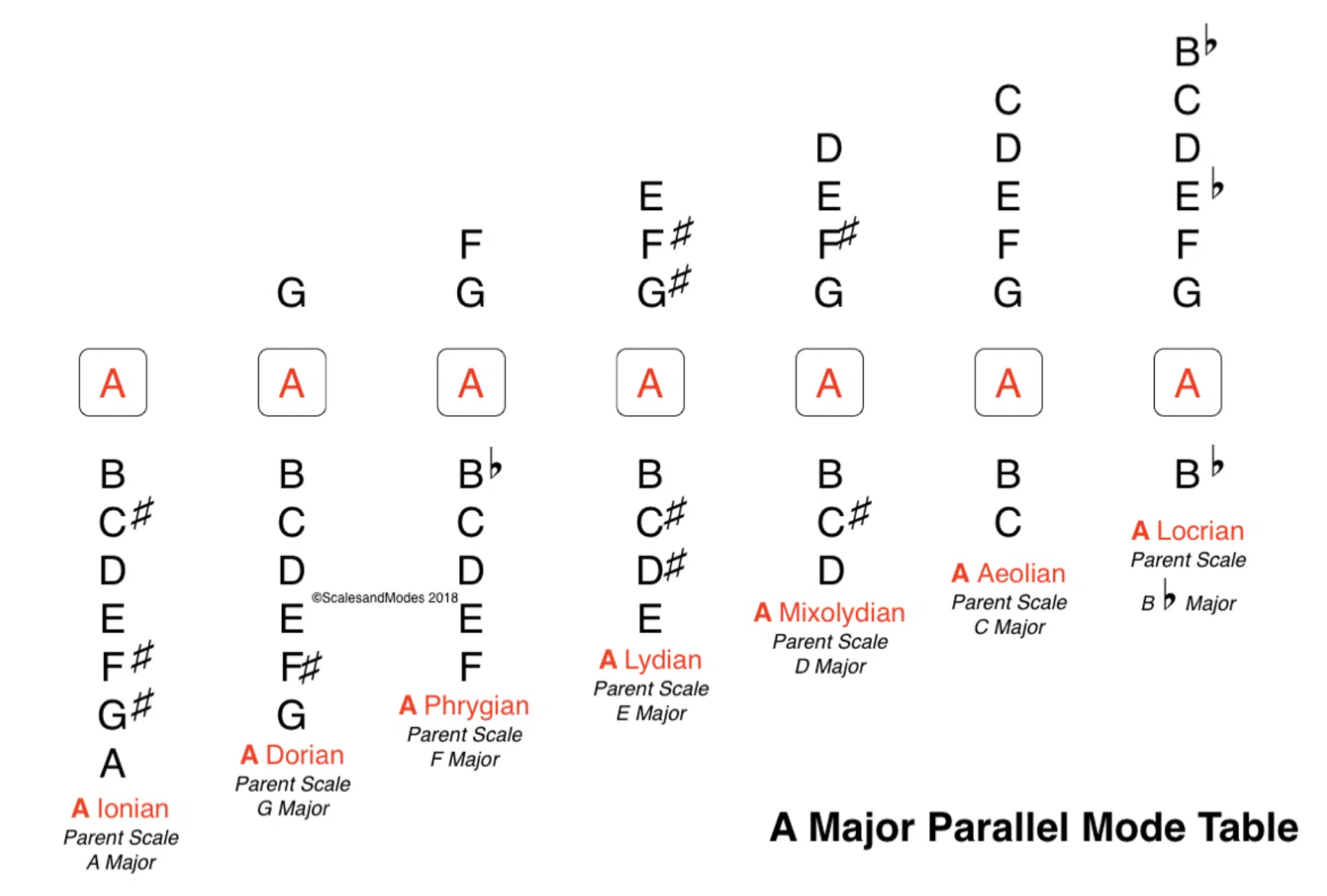
The parent scale method is a practical approach to understanding and working with music modes in music production.
It involves identifying the major scale from which a mode is derived, allowing you to easily transpose, analyze, and create modal progressions and melodies.
- Identify the mode you want to work with.
- Determine the degree to which the mode is based.
- Find the major scale that corresponds to that degree.
- Use the parent scale to create modal chord progressions, melodies, and harmonies.
By mastering the parent scale method, you can efficiently navigate different music modes, enhancing your creativity and expanding your musical palette.
- Dorian Mode 一 Based on the second degree. For D Dorian, the parent scale is C Major (C D E F G A B).
- Mixolydian Mode 一 Based on the fifth degree. For G Mixolydian, the parent scale is C Major (C D E F G A B).
- Locrian Mode 一 Based on the seventh degree. For B Locrian, the parent scale is C Major (C D E F G A B).
Role of Church Modes and Greek Modes
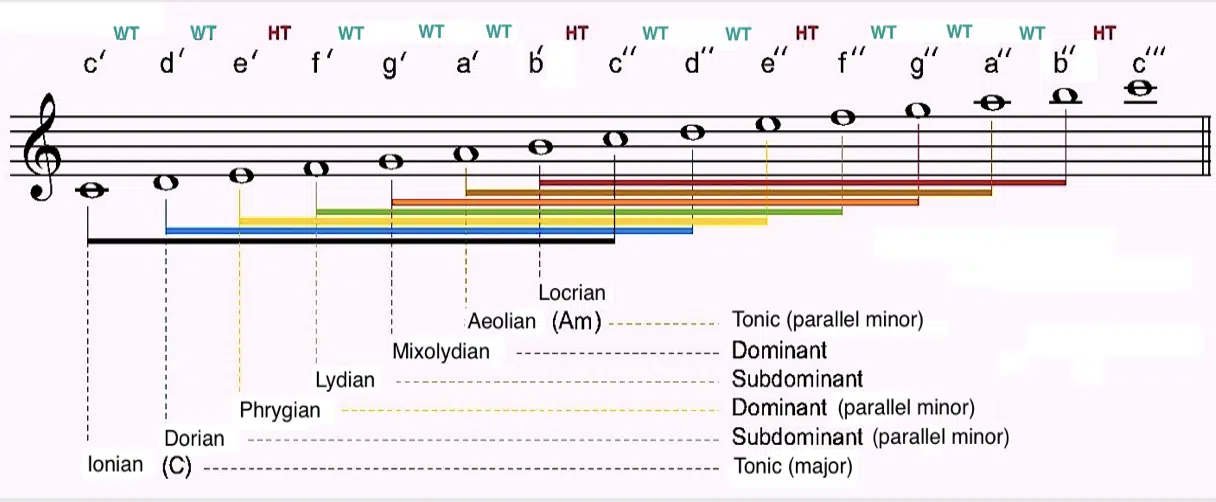
Church music modes and Greek music modes played a significant role in the development of modal music.
The seven modern music modes can be traced back to ancient Greek music history and were later adopted and adapted by the Western church music modes.
Understanding the historical context and evolution of these music modes can provide valuable insights into their use and application in contemporary music production.
Evolution of Modal Music Throughout History
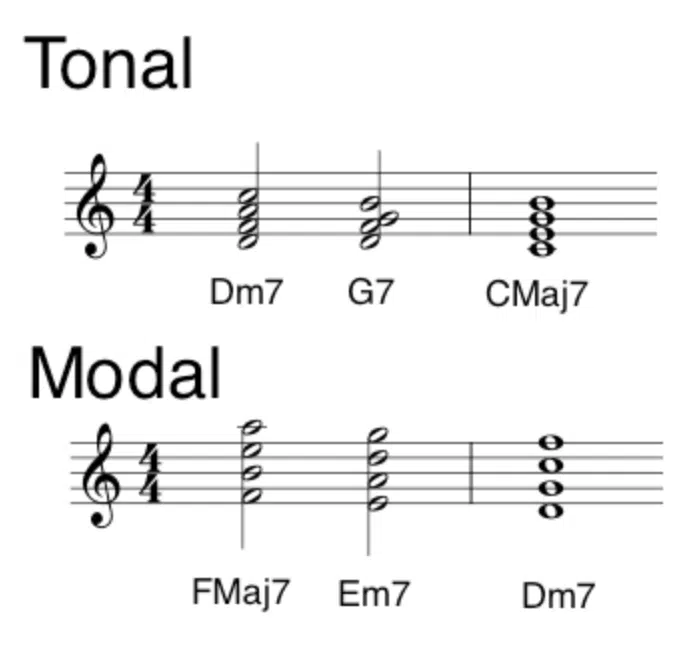
Modal music has evolved significantly over the centuries, with its roots in ancient Greek music theory and its development through the Western church.
Over time, modal music transitioned into the major-minor system, which became the foundation of Western classical music.
However, interest in modal music has resurfaced in recent times, with various genres, including hip-hop, exploring and incorporating different music modes in their beats.
Understanding the historical context of modal music can provide valuable insights into the creative possibilities and applications of music modes.
Tips & Techniques for Incorporating Music Modes
We couldn’t let you go without a few last extra tips and techniques to help excel in your production flow and enhance your music quality.
-
Experiment With Different Music Modes
To unleash your full creative potential, don’t be afraid to experiment with different music modes in your music production.
By exploring various musical modes, you can discover new chord progressions, melodies, and harmonies, ultimately expanding your musical palette.
As you become more comfortable working with modes, you’ll be able to create more innovative and captivating compositions that resonate with your audience.
-
Use Music Modes to Create Unique Melodies & Harmonies
By incorporating different music modes in your music, you can create unique melodies and harmonies that set your tracks apart from the mainstream.
Musical modes offer a wide range of tonal colors and emotional depth.
You can utilize them in order to create memorable hooks, ethereal soundscapes, or evocative storytelling.
Experiment with modal shifts and modulations to create dynamic and engaging compositions that captivate your listeners.
-
Build Tension & Resolution With Modal Shifts
Modal shifts can be used to create tension and resolution within your compositions, adding a sense of drama and emotional depth.
By shifting between different music modes, you can create unexpected twists and turns in your chord progressions and melodies, keeping your listeners engaged and intrigued.
Experiment with various modal shifts to create unique and dynamic tracks that stand out in the hip-hop landscape.
Final Thoughts
As we’ve explored in this article, all the music modes offer a wealth of creative possibilities and opportunities.
Each mode has its unique characteristics, emotional qualities, and applications across various genres.
By understanding and embracing these music modes, you can unlock new dimensions in your music production and create tracks that resonate with listeners on a deeper level.
Don’t be afraid to step out of your comfort zone and explore the potential of these musical modes in your work.
Whether you’re producing hip-hop, electronic, rock, or any other genre, incorporating different music modes can give your music a fresh and distinctive sound.
A great way to start learning about music modes, chord progressions, and scales is to examine chord progressions that are already manipulated to perfection in creative ways.
Luckily, inside the FREE Unison YouTube MIDI Chord Progressions pack you’ll find over 45 chord progressions from artists like:
- Arizona Zervas
- Diplo
- Drake
- Future
- Harry Styles
- Jack Harlow
- Kanye West
- Kendrick Lamar
- Lil Baby
- Post Malone
- The Kid LAROI
- And more
Plus, the included MIDI Chord Progressions are fully customizable, so you can play around with them and learn new and exciting techniques in the process.
Remember, the journey into the world of music modes is not just about learning theory; it’s about applying that knowledge in practical and inventive ways.
Until next time…







Leave a Reply
You must belogged in to post a comment.